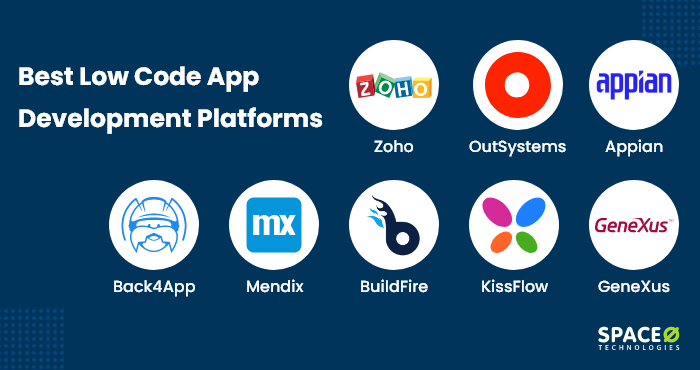Handy Advice For Choosing Low-Code Platform Info
Handy Advice For Choosing Low-Code Platform Info
Blog Article
Benefits Of Low-Code Application Development In Terms Of Integration Capabilities
Low-code integration of applications has many advantages, such as the ability to seamlessly integrate different systems and services. These are the main benefits of pre-built connectors, APIs, and other tools:
An extensive range of connectors. Low-code systems typically include a wide range of built-in connections to business systems that are well-known (e.g. cloud-based services, databases and CRM). This eases the process of integrating with these systems.
API Integration: Many low-code platforms offer API integration capabilities, allowing developers to connect to external service and data sources quickly.
Simple to use:
Drag-and-Drop Interfaces: A variety of integration tasks can easily be accomplished using drag-and-drop interfaces. This allows for developers and other non-developers to develop complex systems with out extensive coding.
Visual Workflow Builders: Visual tools for designing workflows and data flow aid in understanding and setting up integrations more easily.
Standardized Integration Methods:
SOAP and RESTful Services Support for web service protocols like REST and SOAP allows for easy integration with a range of other software and systems.
OData and other Standards: Support for standards such as OData enables easy access and manipulation of data on various platforms and software.
Real-Time Data Synchronization:
Real-Time Integrations: Low-code platforms are capable of handling real-time data transfer between systems and applications. This makes sure that the data is always up-to-date and synchronized across the company.
Event-Driven Architectural: Some platforms feature architectural designs driven by events, allowing applications to respond in real-time to events which are crucial for dynamic, interactive applications.
Legacy System Integration:
Bridging old Systems and New Systems Low-code platform often provides tools for integration with existing older systems. This allows organizations to upgrade their IT Infrastructure without overhauling the current systems.
Data Migration Tool: Built-in data migration tools allow the data to be transferred from legacy systems to new applications that are built on low-code platforms.
Third-Party Integration of Services:
Integration with Cloud Services: Seamless integration with cloud services like AWS, Azure, and Google Cloud allows for the ease of deployment and scaling applications.
Business Applications Low-code platforms can be used to integrate with various business apps like Salesforce, SAP or Microsoft Dynamics. They allow a cohesive workflow for different business functions.
Simplified Data Management:
Unified Data Models: Some low-code platforms offer unified data modeling which makes data integration easier and management across different systems.
Data Connectors: These pre-configured data connectors permit easy access to and manipulation of data from diverse sources.
Security and Compliance
Secure Integrations: Low code platforms guarantee that integrations adhere to security protocols as well as standard safeguarding data while in transportation as well as during rest.
Security Features: These platforms typically have features that assure that integrations are in compliance with regulations, for example GDPR or HIPAA. This gives security for companies handling sensitive information.
Extensibility:
Low-code platforms often meet complicated integration requirements by incorporating custom code or scripts. They provide flexibility, but without sacrificing their user-friendliness.
Plug-in Ecosystems : An eco system of plugins and extensions allows users to expand the possibilities of integration. They can add new features as they need.
Low-code platforms provide a powerful instrument to create interconnected effective and scalable applications. They help connect various platforms. They also enhance the flow of data. Have a look at the most popular Low-code Platform for application development examples for more info including cross platform mobile dev, ms azure sql, cross platform app development, low code platforms, cross platform app dev, develop cross platform mobile app, application modernization software, application modernization software, app modernisation, cross platform mobile app development and more.
Advantages Of Low Code Application Development For Governance And Security
Low-code applications offer a number of advantages in terms of security and governance. These are essential for ensuring that the application is compliant and secure. They also ensure that they are well-managed throughout their lifespan. Here are the benefits of developing low-code applications:
Unified management console: Low code platforms typically have a central administration console from which administrators are able to manage all the applications and ensure that there is a consistent management within the organization.
Role-Based Access Control RBAC (RBAC). These platforms often have robust access control that is by role, which gives administrators to create and enforce their own access policies. This guarantees that only authorized users can access or modify particular elements of an application.
Compliance and Regulatory Adherence
Built-In Compliance Features: Many low-code platforms are designed to conform to industry standards and regulations (e.g., GDPR, HIPAA). These platforms offer frameworks and tools to make sure that applications are in compliance with these requirements.
Audit Trails and Logging Audit trails, comprehensive logging and logs are usually integrated into companies that allow them to keep track of changes and track access. They can also make sure that the organization is in compliance with external and internal regulations.
Improve Security Measures
Data Encryption : Low-code platform typically provide built-in encryption of data at rest and during transit. This guarantees that sensitive information will be protected.
Security Certificates: A lot of low code providers have security certificate (e.g. ISO 27001 and SOC 2) which demonstrate they adhere to the strictest security guidelines. They provide an additional security level to their customers.
Automated security updates:
Regularly scheduled updates and patches: Low-code platforms typically handle security updates and patches automatically, making sure that applications are secure from latest threats without manual intervention from developers.
Security Monitoring: Continuous security monitoring tools are included to provide real-time notifications as well as information about potential security problems.
Data Governance
Data Access Policies These platforms allow organizations to define and enforce their data access policy and ensure only authorized users have access to data and that it is properly used.
Data Masking and Anonymization The built-in tools for masking data and anonymization help protect sensitive data, particularly in development and testing environments.
Consistent Application Lifecycle Management:
Pipelines for development and deployment Lowcode platforms usually provide integrated pipelines for development and deployment that include security checks. They provide security throughout the entire lifecycle of an application.
Version Control. Integrated version management helps identify and reverse any modifications that are made to the program, while ensuring that the integrity of it is protected.
Authorization, User Authentication and Authorization
Single Sign-On Support for single sign-on (SSO), and other advanced mechanisms of authentication makes management easier and improves security.
Multi-Factor Authentication Numerous platforms can support multi-factor Authentication, which adds an extra layer to security when accessing apps.
Monitoring Policy Enforcement
Low-code platforms include policies that are predefined to help organizations implement security and governance policies as well as governance policies.
Tools for Monitoring Compliance The tools offer regular monitoring and report on compliance status, making it easier to recognize and resolve any issues that could arise.
Integration into Existing Security Infrastructure
Seamless integration: Low-code platforms are able to be seamlessly integrated with existing security tools and systems like firewalls, SIEM solutions (Security Information and Event Management), and identity management systems.
API Security: API security features which protect data and maintain the integrity of the application are integrated into the API.
Training and best Practices
Guided Best Practices: Many platforms offer guidelines and best practices to assist non-developers comply with security standards.
Some low-code providers provide security education to help users learn how to develop and maintain secure applications.
Overall, governance and application security advantages ensure that applications will be built and managed securely while remaining in compliance with the regulations and under control. These platforms offer the tools and frameworks needed to protect sensitive data, enforce policies, and keep regulatory compliance in place, all while facilitating the administration and supervision of the process of developing applications. Have a look at the recommended full report about Enterprise application development with Low-code Platform for more examples including push alerts, multiplatform mobile app development, cross platform mobile app development, app modernisation, cross platform mobile dev, develop web app, app modernization, cross platform mobile dev, multiplatform mobile app development, software for app development and more.
In Terms Of Support For Vendors And Community, Low-Code Applications Development Offers Many Benefits.
Low-code platforms provide significant benefits in terms of community and vendor support Both of which are crucial to the an effective installation, maintenance and enhancement of applications. Here are the major benefits: Support from the vendor
Comprehensive Technical Support:
Dedicated Support Team: Many low code platforms have dedicated support staff who can assist with technical questions in troubleshooting and advice. They can make sure that issues are resolved promptly.
24/7 Support Certain vendors are accessible around the clock and this is helpful for companies operating in different time zones.
Training and Onboarding
Structured Training: A number of vendors offer structured training, including webinars, tutorials, and certification courses to help users quickly become comfortable with the platform.
Personalized onboarding: Many vendors have personalized services for new customers, to help them implement the platform properly and to tailor it to suit their needs.
Regular Updates and Enhancements
Continuous Improvement : Low-code platforms manufacturers often release regular updates which include new features as well as performance improvements and security patches. These updates ensure that their platform remains up to date and secure.
Feedback Integration: Vendors include user feedback in their cycle of development to ensure that the platform is continually evolving to meet the ever-changing needs of their users.
Comprehensive Documentation:
Documentation - In depth Documentation: A complete and well-organized document covering everything from basic use to advanced customizations, is often available. This allows users to solve issues on their own.
API References: API documentation is detailed and assists developers in integrating the platform with other systems, and also to customize their applications.
Consulting and Professional Services
Expert Consulting : Vendors offer consulting services, such as the design of architectures and complicated implementations. They offer this service in order to make sure that their users can benefit from the platform.
Custom Development Services: A few providers offer custom development services that allow you to develop specific features or integrations that are not included in the default.
Community Support
Active User Communities
Forums and Discussion Panels: Many Low-code platforms feature vibrant online communities where users can ask questions, debate strategies, and even collaborate on best methods.
User Groups and Meetings: Both local and virtual groups of users and meetups provide opportunities to learn, network, and share experiences with other users.
Knowledge Sharing and Collaboration
Community-Contributed Resources: Users often share templates, modules, and extensions that they have developed, which can be reused or adapted by others, accelerating development and innovation.
Crowdsourced Solutions: The collective wisdom, experience and expertise of a group can be an effective tool for troubleshooting and finding creative solutions.
Learning and Development
Community-Led Learning: Several communities host workshops, training sessions and webinars that are often directed by experts who are able to provide insight and advanced techniques.
Online Tutorials & Courses: Members of the community frequently publish online tutorials, classes, and instructions on how to accomplish things, which enhances learning resources.
Feedback and Influence:
Product Feedback: Many community forums have channels for giving feedback to manufacturers. This could influence the development of the development of new features and enhancements.
Beta Testing Active communities may have an opportunity to be part of the beta testing process. This allows them to get early access and be involved in the design of the platform.
Recognition and Encouragement
A lot of vendors have community recognition programs, like MVP programs (Most Valuable Professional) that recognize the contribution of those who are involved in their communities.
Peer Support. Community members provide peer support. They share their expertise with less experienced users and provide guidance. This creates an atmosphere that is supportive and collaborative.
Overall, the combination of robust vendor support with an active and engaged community creates a comprehensive support eco-system for low code application development. Users will have the knowledge and resources needed to build the application, deploy it and keep it running. application.